Few foods evoke more memories for Chinese from Hawai'i than Gau. For me, Gau is about waking up to the sound of firecrackers popping outside of my Popo Chun's temple at 6:00 am on Chinese New Year's Day. I'm five years old again and I wake up with the happy thought that if I run over to my Popo's house before school with my brother, Merrill, and wish her a "Gung Hee Fat Choy!" I will be rewarded with a leesee. This will contain the small fortune of a crisp $5.00 bill. In the mid 50's this amount would mean spending money for months into the future! So many things to consider: a new kite? a new yoyo? an Archie or Richie Rich comic? a wooden top to add to my growing collection? a gooey paper bag of apricot mui from Wing Coffee where my Aunty Wilma works?
Three foods were always present at Chinese New Year's. There was a huge Gau from my Popo, ten inches across, four inches high with sesame seeds sprinkled over the top and crowned with a single red date in the center. There was Jai, which I never cared for, once my older and supposedly wiser cousin solemnly informed me that the bok gwo, the white nuts, were actually frog's eyes. Not. It took me into my adult years before I tried Jai again and loved it. There was impossibly thin Jin Duey. So spoiled. I sometimes ate the sweet black bean-filled Jin Duey straight from the hot oil in my Popo's gigantic wok. Hot, crisp, perfect Jin Duey. Big Sigh!
It's 2008 and I've coordinated a gathering of Gau-proficient friends for Food Editor Wanda to meet for an Advertiser article. These happy women, in their forties to eighties, make and bring a total of 8 different kinds of Gau (most importantly, with treasured recipes!) to my friend, Elsie's, Aina Haina home. It started with an email from Wanda asking me Gau questions regarding my mother's recipe I'd emailed her last year. At least ostensibly it was supposed to be a Gau demo and exchange but it was, what every gathering of locals becomes, a PAR-TAY! Elsie repeatedly assured me that she wouldn't go through any trouble. I repeatedly assured her that we would take care of everything. Wanda brought all the ingredients from a detailed and far-flung products list. I was in charge of the hard ware, the mixing, steaming and baking equipment. Elsie said she would serve just "tea" for our little yum cha.
Well, Elsie made enough lunch for a small army although there were only 6 of us, plus, we all took home leftovers. She'd whipped up a huge layered overnight salad, her Aunt Bina's Portuguese Lima Bean Soup and date cake. All delicious, all from scratch. How do these women do that overnight? It's magic.
Elsie is a firecracker of a woman and at 88 with more energy than an 8 year old. Her friend, Gladys was so humble but a fount of Chinese lore and tradition. Sweet Cathy, who knows Elsie too, was the hard worker in the background making it so easy for us to do our tasks. Wanda was there with her camera, camcorder and notepad, asking astute questions to capture this moment. Deborah, the Advertiser photographer, arrived precisely an hour after the rest of us did, as planned, to give us the requisite time to talk story, exchange New Year presents and meet and greet.
The Gaus were all different but had the common denominator of being 'ono. Wanda brought a Shanghainese microwaved Gau chock full of red jujubes and pinenuts. This recipe was taught to her by the gal who teaches the Narcissus Queen participants. Cathy brought an unusual white Nian Gau from a Hanahau'oli cookbook. It had dried cherries and walnuts. I brought three versions of Gau from two recipes. There was the traditional steamed Gau with yams taught to me by my friend Susan 15 years ago. While steaming takes a minimum of 4 hours, I also baked the same batter for 1 hour. My mother's modern baked Gau with tsubushian that I brought was well received. Cathy and I made a modern steam/baked Gau with coconut milk during the gathering.
The main event was the involved and complicated process of making the traditional Gau by Gladys and Elsie. Cathy and I would take turns with mixing our simpler baked Gau in order to run back and forth to catch all the snippets of important information being generously doled out by Gladys and Elsie. First, they spent a half hour creating a ti leaf basket for the Gau to steam in. This was probably the first culinary nonstick surface. Then, they mixed the Gau batter by hand all the while relying on eye and instinct to determine the correct consistency. Elsie patiently watched the steaming pot for over 7 hours! Each procedure has its own distinct set of skills. We all felt very honored and humbled to be present to watch this re-creation of a favorite childhood sweet.
At lunch, we enjoyed (small) pieces of each of the many Gaus. Wanda brought a sample plate to the sophisicated palates of the Advertiser newsroom. I was so pleased to hear that my friend, Susan Chock's, traditionally steamed yam Gau turned out to be a favorite for both groups, that I raised both hands in the air and shouted "Yay!" as if I'd won an Olympic event!
-foodiewahine
Susan Chock's Gau
(Thank you Susan, for sharing your recipe, it's so precious to us!)
3 (1 lb.) boxes Mochiko
3 (1 lb.) packages of Wong Tong, Chinese brown sugar in blocks. 7 slabs to a pkg. Do not substitute regular brown sugar.
2 -3 lbs. fresh yams. No substitutions. Yams have a maroon skin, orange flesh.
3 cups water (opt.: Can add coconut milk but reduce water proportionately. Gau will then need refrigeration)
Washed ti leaves or dried bamboo leaves which are soaked for two days in water to soften.
Four 8" steaming baskets or pans
sesame seeds
Optional: 1 red date, Hung Jo, a jujube
The day before, cook yams with the peel on, in water to cover for approx. 45” until very soft or microwave. Peel, cool, set in the refrigerator overnight.
Melt brown sugar in 3 cups of water over medium heat until melted, about 15 min. Cool completely.
Line bamboo steamer containers with ti leaves in a circular pattern covering the steamer basket completely. May use string to create a collar.
Mash yams, taking out any large fibers or eyes. Mix sugar-water, mochiko and yams first with a wire whisk then by hand. This is like kneading. The batter should be like a stiff, very thick cake batter. You may have to add up to another 1 cup of water for the right consistency.
Place the batter into the steaming baskets that are lined with ti leaves. Place bamboo baskets in a pot for steaming over 1” of water. First bring to a boil then turn down to a high simmer but do not boil constantly. Place a thin dishtowel over the top of the pot under the lid. Check every hour to make sure that no water is dripping back down onto the gau during the steaming. Steam for 4 hours. Cool completely. A plastic knife will cut through the gau without dragging.
Servings: approximately 36
Note: you can cut the recipe by 1/3 by using 2 lbs. of mochiko, 2 blocks of sugar, etc. You can also use any available assortment of different sized baskets, cans and pans.
____________________________________________________________________
A HUGE Mahalo to Wanda, Elsie, Cathy, Gladys and Deborah for a wildly fun and successful Gau Fest. It would not have been possible without the generosity of those (Susan!) who shared their treasured family recipes.
Wanda Adam's informative and lively Gau-a-thon (her name for it) article with accompanying recipes, photos and video are on the Honolulu Advertiser's website for Jan. 23rd, 2008 in the Taste section.
Chinese New Year's falls on February 7 this year. Support your local Chinatowns.
____________________________________________________________________
Copyright 2007-2008. Anything to Eat. All rights reserved. This material and all material on this site may not be published, broadcast, rewritten or redistributed without permission. The author disclaims all liabilities in connection with the use of the information contained within.
Subscribe to:
Post Comments (Atom)

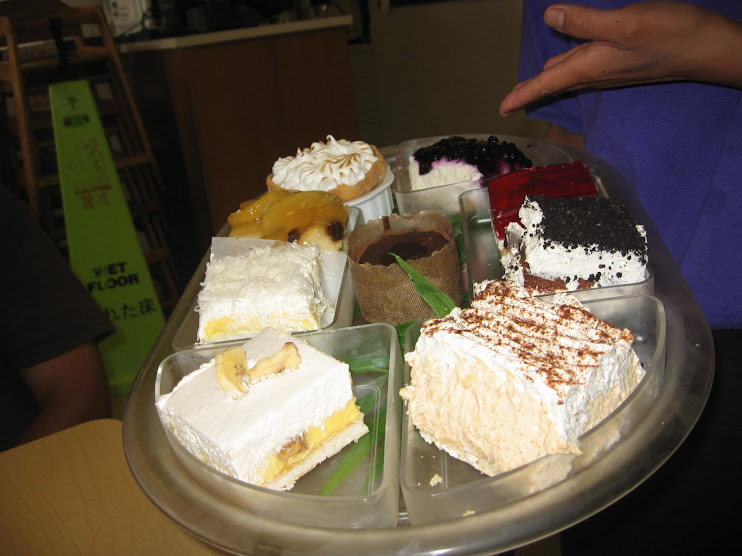
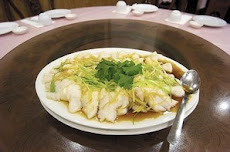




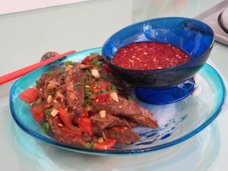




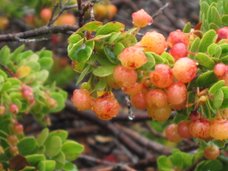
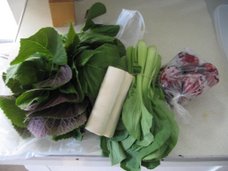
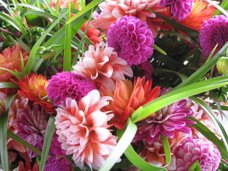
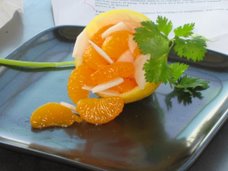
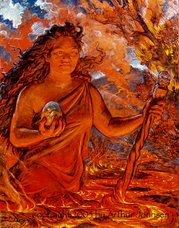
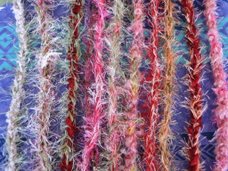



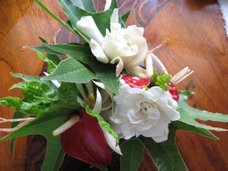
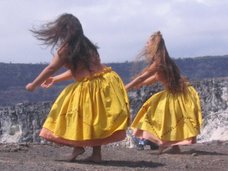
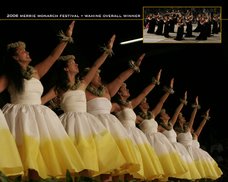
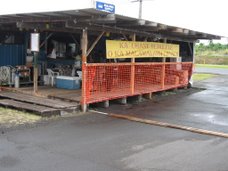
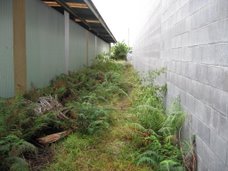
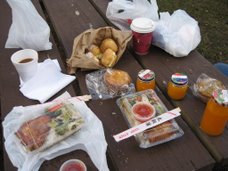


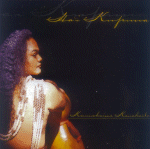

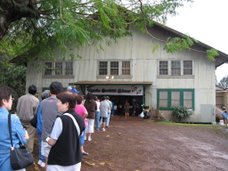
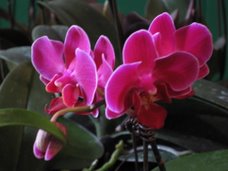
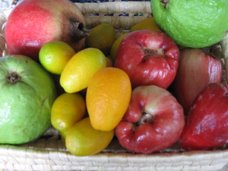

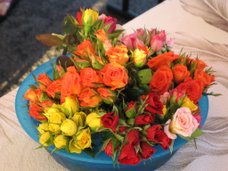
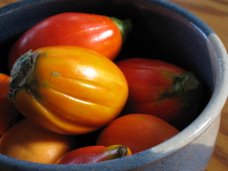
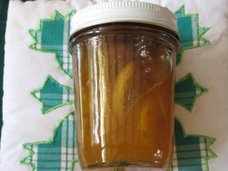
6 comments:
Wow...what an amazing experience!! You are so lucky to have all of those people in your life to share their precious recipes and expertise with you. I loved reading about your childhood memories also and the "hot jin duey!!
Love,
TSB
XXXOOO
Dear TSB,
We share our Chinese legacy and traditions and a gazillion other things, TSB. I am lucky to have you as a loyal friend and constant source of support! If we lived in the same place we'd be figuring out the key to the world's best jin duey together.
Love,
foodiewahine
i loove your Gau Marylene! its mildly sweet and tastes like honey and tea was infused in it.
Aloha, Samantha,
That's an interesting description and both accurate. I think you get the honey hit from the Chinese brown sugar slabs and the tea, herbally flavor from the steamed ti leaves.
Samantha is referring to Susan's Yam Gau recipe.
-foodiewahine
If anyone is interested in teaching how to make perfect, crisp jin duey. Please write in the comment section!
auntie marylene,
i enjoyed your gau article; reading your blog always makes me feel like i'm "home."
btw...during christmas, i was going to buy wanda's new cookbook, that was dedicated to you, for my mom (bette), and one for rose & i. unfortunately, it wasn't available yet at borders.com. funny thing - my mom was going to buy us the same christmas gift!
miss you and the family.
love,
sf nephew
Dear sf nephew,
The excitement and planning must be building over your big event this summer!
FYI: Wanda's book is in its second printing now so there was a mixup on the orders. For those off-island, I think the book is now available on amazon.com at the best price online, 10.85.
fooodieauntie
Post a Comment